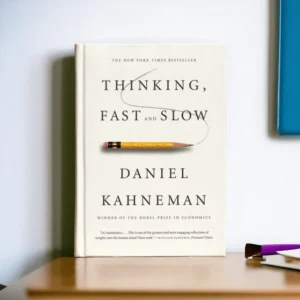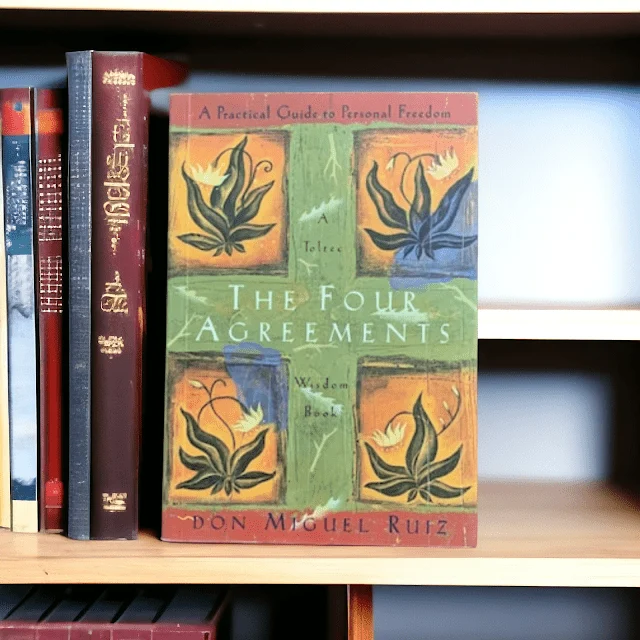A Groundbreaking Exploration of the Mind
Few books have transformed our understanding of human decision-making and cognitive biases as profoundly as Thinking, Fast and Slow by Daniel Kahneman. Written by a Nobel Prize-winning psychologist, this book delves into the intricate workings of the human brain, shedding light on how we process information, make choices, and fall into predictable mental traps.

Kahneman introduces the revolutionary concept that our thinking operates through two distinct systems:
- System 1 (Fast Thinking) ⚡ – Intuitive, emotional, and automatic. While it allows for rapid responses, it is prone to errors and cognitive biases.
- System 2 (Slow Thinking) 🧠 – Rational, deliberate, and logical. This system demands effort and concentration, leading to more thoughtful and accurate decisions.
Understanding how these two systems interact enables us to make better choices, mitigate biases, and refine our critical thinking skills in everyday life.
1️⃣ What Is Thinking, Fast and Slow About?
🔹 The Two Systems of Thought
Kahneman’s core premise is that our brains function in two fundamentally different ways:
✅ System 1 (Fast Thinking) ⚡
✔️ Operates automatically and effortlessly.
✔️ Governs instincts, snap judgments, and quick decisions.
✔️ Examples: Recognizing faces, avoiding immediate danger, finishing common phrases.
✔️ Downside: Susceptible to cognitive biases and systematic mistakes.
✅ System 2 (Slow Thinking) 🧠
✔️ Requires effort, deep concentration, and logical analysis.
✔️ Used for problem-solving, strategic thinking, and rational decision-making.
✔️ Examples: Solving mathematical equations, making long-term plans, engaging in critical debates.
✔️ Downside: Energy-intensive and can be overridden by the more dominant System 1.
By recognizing when to rely on each system, we can make more rational choices and avoid being misled by mental shortcuts.
🔹 The Biggest Cognitive Biases & Mental Traps
Kahneman exposes the systematic errors that distort our thinking, leading to flawed decision-making. Some of the most significant biases include:
✔️ Anchoring Effect ⚓ – Our judgment is influenced by the first piece of information we encounter, even if irrelevant. (Example: Seeing an overpriced item first makes other prices seem more reasonable.)
✔️ Loss Aversion 📉 – We fear losing more than we value gaining, leading to poor financial and life decisions.
✔️ Overconfidence Bias 💭 – We overestimate our knowledge and abilities, often making risky decisions based on false confidence.
✔️ Availability Heuristic 🔍 – We judge probabilities based on recent or memorable events rather than actual statistics. (Example: People fear flying more than driving, despite car accidents being far more common.)
✔️ Framing Effect 🎭 – The way information is presented changes our perception. (Example: A “90% survival rate” sounds more reassuring than a “10% death rate,” even though they mean the same thing.)
Recognizing these mental traps helps us make more objective and rational decisions.
2️⃣ What Can You Gain from Reading This Book?
This book fundamentally changes how you think about thinking. It provides invaluable insights into human cognition and equips you with tools to enhance your decision-making skills.
✔️ Make Better Financial Decisions – Learn to avoid impulsive spending, recognize bad deals, and make smarter investments.
✔️ Improve Negotiation & Persuasion Skills – Master how anchoring, framing, and biases influence decision-making.
✔️ Control Emotional Reactions – Distinguish between instinctive responses and rational thought.
✔️ Enhance Problem-Solving & Critical Thinking – Utilize System 2 thinking to tackle complex issues more effectively.
✔️ Understand Human Behavior – Gain a deeper insight into why people act irrationally and how to anticipate their choices.
Unlike typical self-help books, Thinking, Fast and Slow is grounded in decades of rigorous research and real-world experiments. Kahneman presents evidence-based strategies to help you sharpen your cognitive skills and avoid mental pitfalls.
3️⃣ Who Is Daniel Kahneman? How Popular Is Thinking, Fast and Slow?
🖊 About the Author: Daniel Kahneman
✔️ Who Is He? A world-renowned psychologist and Nobel Laureate, known for his groundbreaking work in behavioral economics and cognitive psychology.
✔️ His Legacy: His research reshaped economics, psychology, and decision science, influencing industries ranging from finance to policymaking.
✔️ Who Uses His Teachings? Investors, policymakers, business strategists, behavioral scientists, and anyone seeking to understand human thought processes.
📊 Sales & Global Influence
📌 First Published: 2011
📌 Estimated Copies Sold: Over 2.5 million
📌 Languages Translated: Over 40
📌 Who Reads It? CEOs, entrepreneurs, academics, and critical thinkers worldwide.
Widely regarded as one of the most important books on psychology and decision-making, it remains a must-read for those who seek to understand and master human cognition.
4️⃣ How Does Thinking, Fast and Slow Compare to Other Books on Human Behavior & Decision-Making?
🔥 Top Psychology & Self-Improvement Books: Which One Should You Read? 🔥
Looking for the best books on psychology, behavioral science, and self-improvement? This ultimate comparison breaks down the key features of five must-read books, including scientific depth, engagement, practical application, and main focus. Whether you’re a deep thinker, a marketer, or someone looking to build better habits, this guide will help you pick the perfect book. Let’s dive in! 📚
1. Thinking, Fast and Slow – Daniel Kahneman 🧠
- 🎯 Best For: Deep thinkers & those seeking a rigorous exploration of biases.
- 🏆 Scientific Depth: Extremely high – a deep dive into cognitive psychology.
- 🎭 Engagement & Storytelling: Moderate – insightful but can be dense at times.
- 🎯 Practical Application: High – great for understanding and improving decision-making.
- 🔍 Main Focus: Cognitive biases & decision errors.
- Why Read It? A masterpiece on how our minds work, perfect for understanding human behavior.
2. Predictably Irrational – Dan Ariely 🤯
- 🎯 Best For: Readers who enjoy entertaining insights into irrational behavior.
- 🏆 Scientific Depth: High – based on behavioral economics research.
- 🎭 Engagement & Storytelling: Very high – fun, relatable, and engaging.
- 🎯 Practical Application: Moderate – more about understanding than actionable steps.
- 🔍 Main Focus: How irrationality shapes our choices.
- Why Read It? A fun and eye-opening exploration of why we make illogical decisions.
3. Influence: The Psychology of Persuasion – Robert Cialdini 🎭
- 🎯 Best For: Salespeople, marketers & anyone interested in persuasion.
- 🏆 Scientific Depth: Moderate – focuses on practical principles of influence.
- 🎭 Engagement & Storytelling: High – filled with real-world examples and anecdotes.
- 🎯 Practical Application: Very high – actionable strategies for persuasion.
- 🔍 Main Focus: The science of influence & manipulation.
- Why Read It? A must-read for mastering the art of persuasion in business and life.
4. Atomic Habits – James Clear 🔄
- 🎯 Best For: Those who want to build better habits effectively.
- 🏆 Scientific Depth: Moderate – combines research with practical advice.
- 🎭 Engagement & Storytelling: High – clear, concise, and motivating.
- 🎯 Practical Application: Very high – step-by-step guidance for habit formation.
- 🔍 Main Focus: Behavioral change & habit formation.
- Why Read It? A practical guide to creating lasting habits and achieving your goals.
5. The Power of Habit – Charles Duhigg 🔄
- 🎯 Best For: Readers interested in how habits work at a personal & societal level.
- 🏆 Scientific Depth: High – explores the science behind habit loops.
- 🎭 Engagement & Storytelling: Moderate – informative but less narrative-driven.
- 🎯 Practical Application: Moderate – more about understanding habits than actionable steps.
- 🔍 Main Focus: The science of habit loops.
- Why Read It? A fascinating look at how habits shape our lives and organizations.
Which Book Should You Read? 🤔
- 🧠 Deep Thinkers: Thinking, Fast and Slow
- 🤯 Fun Insights: Predictably Irrational
- 🎭 Persuasion Skills: Influence: The Psychology of Persuasion
- 🔄 Habit Building: Atomic Habits
- 🔄 Habit Science: The Power of Habit
While Thinking, Fast and Slow provides the deepest scientific foundation, it is denser than other books, making it ideal for those who enjoy a more academic approach. In contrast, books like Influence and Atomic Habits offer more accessible and actionable insights for everyday life.
📌 Final Verdict: Should You Read Thinking, Fast and Slow?
If you are fascinated by the inner workings of the mind and want to understand the science behind decision-making, biases, and rational thinking, Thinking, Fast and Slow is an essential read. While it requires patience and careful study, the rewards are profound: a clearer, sharper, and more rational approach to life’s choices.
✔️ Highly recommended for: Deep thinkers, strategists, financial experts, business leaders, and psychology enthusiasts.
✔️ Not ideal for: Readers looking for light, action-oriented advice or quick self-improvement tips.
Kahneman’s masterpiece is a game-changer—one that will forever alter how you think about thinking. 🧠










